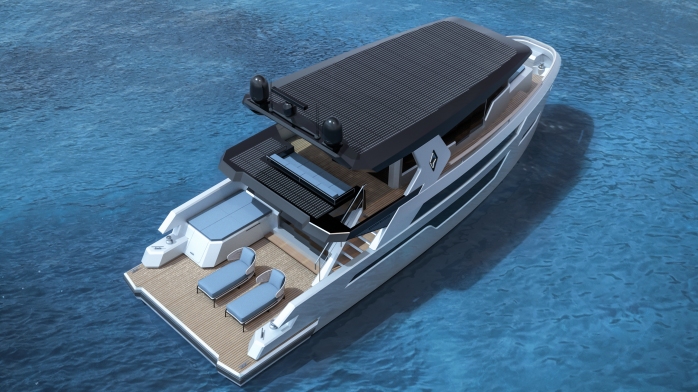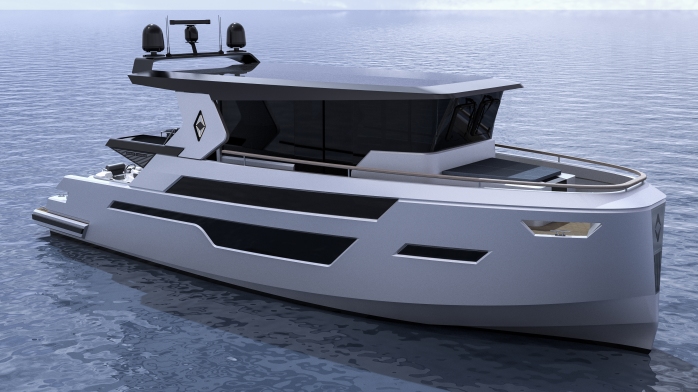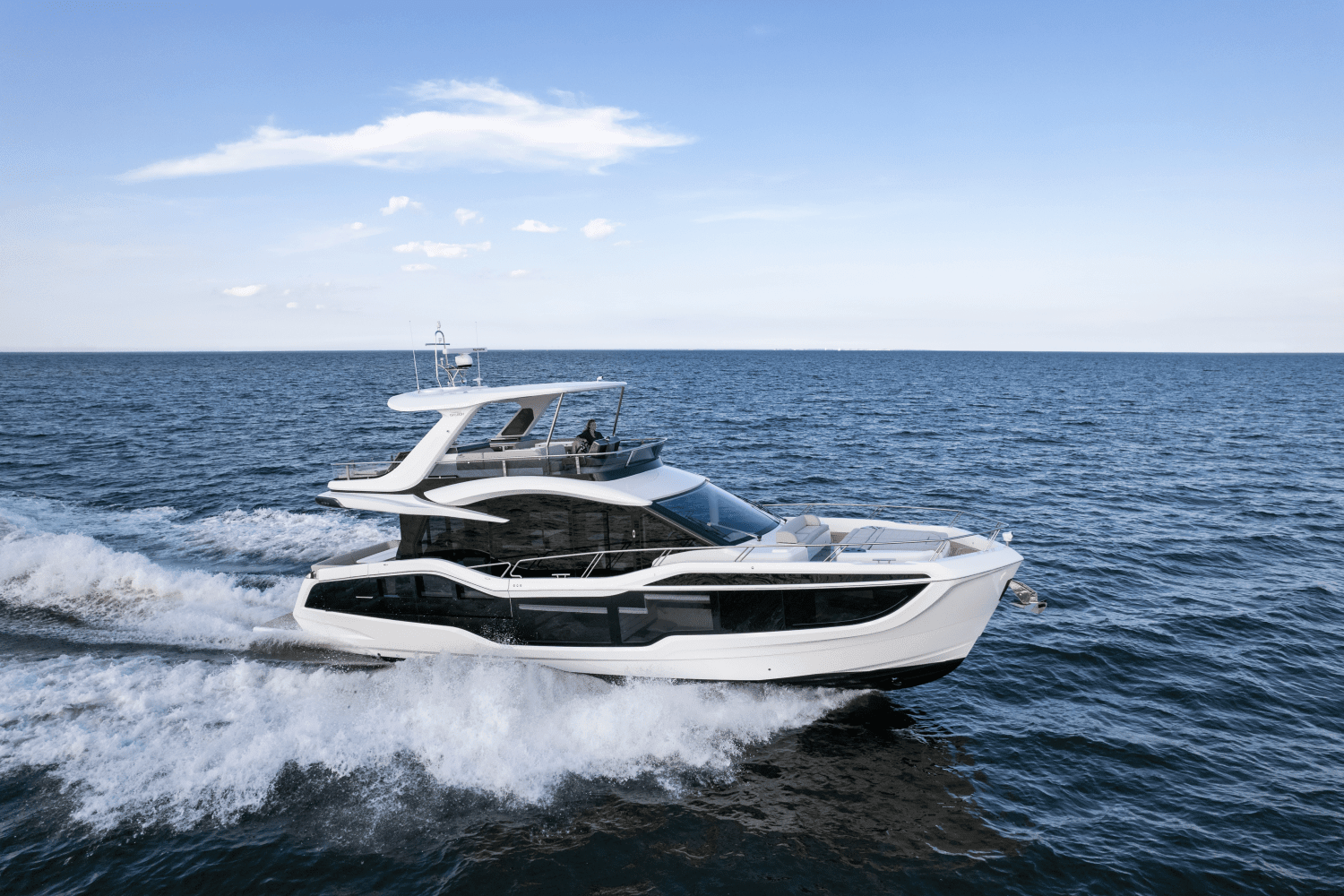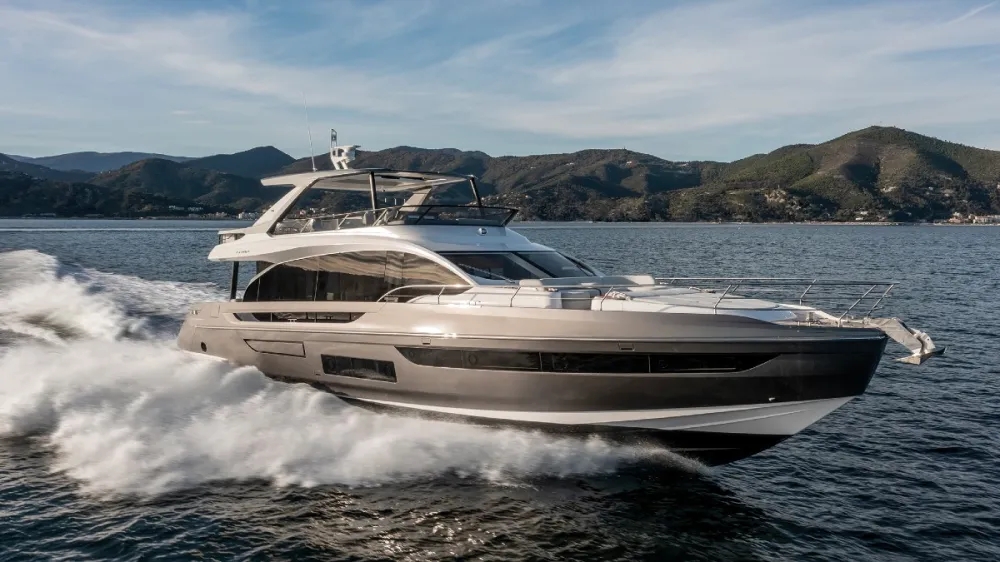Eco-Inspired Alva Yachts EC50 Unveiled
Heralding a new focus on the environment in the post-Covid world, a young German brand is launching an advanced range of sustainable catamarans and yachts. Founded in early 2020, Alva Yachts has announced their Eco Cruiser 50: it is their first monohull electric Yacht, powered by electric motors, with solar panels and hydrogen fuel cells for totally clean navigation, the 50 represents the founder’s ethos of sustainability at the heart of its yachts. The WSB team take a closer look at this inspiring new brand Alva Yachts.
• It is the first monohull electric motor yacht by Alva Yachts
• It will be powered by electric motors connected to a battery pack
• The battery pack takes energy from a generator and from solar panels
• A 100% green vessel, the generator can be replaced by a hydrogen tank with fuel cells
• The unique layout with beach area, upper and lower deck offers unprecedented space
• Different layouts and solutions are available to best suit the owners’ needs
 Alva Yachts, the German shipyard of electrical floating solutions, takes another step forward and launches its first monohull electric yacht, named Eco Cruiser 50. It is a 15.20-meter motor yacht, specifically designed for electric propulsion, with a peculiar layout made to maximize space and customized solutions with plenty of possibilities for the interiors.
Alva Yachts, the German shipyard of electrical floating solutions, takes another step forward and launches its first monohull electric yacht, named Eco Cruiser 50. It is a 15.20-meter motor yacht, specifically designed for electric propulsion, with a peculiar layout made to maximize space and customized solutions with plenty of possibilities for the interiors.
 It has been designed by Henndesign to perfectly suit customers who like to cruise and explore while yachting. At 50 feet, it will be the smallest model in the Alva Yachts range, meant to reach new markets and especially a wider range of boaters.
It has been designed by Henndesign to perfectly suit customers who like to cruise and explore while yachting. At 50 feet, it will be the smallest model in the Alva Yachts range, meant to reach new markets and especially a wider range of boaters.
 The first key point of Eco Cruiser 50 is of course the electric propulsion. Alva Yachts has already developed electric catamarans (Ocean Eco 60 and 90 are in construction), an electric-assisted sailing vessel (Ocean Sail 82), and floating villas. The Eco Cruiser 50 is a step further, as the electric powertrain is now taken onto a monohull yacht.
The first key point of Eco Cruiser 50 is of course the electric propulsion. Alva Yachts has already developed electric catamarans (Ocean Eco 60 and 90 are in construction), an electric-assisted sailing vessel (Ocean Sail 82), and floating villas. The Eco Cruiser 50 is a step further, as the electric powertrain is now taken onto a monohull yacht.
 Eco Cruiser 50 is shaped around a solar and electric approach towards yachting: different from other yachts the technology is not an add-on but a central design feature. The most obvious characteristic that underlines this fact is the impressive roofline that creates a larger roof surface for solar panels. More solar panels are also housed in the overhang of the upper deck.
Eco Cruiser 50 is shaped around a solar and electric approach towards yachting: different from other yachts the technology is not an add-on but a central design feature. The most obvious characteristic that underlines this fact is the impressive roofline that creates a larger roof surface for solar panels. More solar panels are also housed in the overhang of the upper deck.
 Eco Cruiser 50f+ features 2 electric motors delivering 100 kW each, for a total output of 272 hp. The power to supply the engines comes from a generator (50 kVA) and from solar glass tiles on the roof (4.9 kWp), and it is stored into a 140 or 240 kWh battery pack.
Eco Cruiser 50f+ features 2 electric motors delivering 100 kW each, for a total output of 272 hp. The power to supply the engines comes from a generator (50 kVA) and from solar glass tiles on the roof (4.9 kWp), and it is stored into a 140 or 240 kWh battery pack.
 The cleanest solution replaces the generator with a hydrogen fuel cell and the normal fuel tank with hydrogen storage tanks. In this case, the Eco Cruiser 50 is 100% clean, as it can cruise without releasing any polluting emission and in total silence. Alva Yachts has also considered seafarers who want more performance even from an electric yacht and offers a Power Version of the Eco Cruiser 50, named 50 HP, with two 230kW electric motors for a total of 625 hp. In this case, the maximum speed can reach 20 knots.
The cleanest solution replaces the generator with a hydrogen fuel cell and the normal fuel tank with hydrogen storage tanks. In this case, the Eco Cruiser 50 is 100% clean, as it can cruise without releasing any polluting emission and in total silence. Alva Yachts has also considered seafarers who want more performance even from an electric yacht and offers a Power Version of the Eco Cruiser 50, named 50 HP, with two 230kW electric motors for a total of 625 hp. In this case, the maximum speed can reach 20 knots.
 Alva Yachts and Henndesign have also given the Eco Cruiser 50 a peculiar layout, made to maximize space and comfort. A large beach club area, much more than a swim platform (it measures 22 sqm), houses a sun pad but also holds the yacht’s tender and a jet ski. From here, four steps down lead to the lower deck, while a starboard staircase takes to the upper one. The outside areas do not end in the ample beach club but continue upstairs with a raised and protected cockpit featuring a couch and two tables, and with two wide passageways that lead to the foredeck large sun pad. The inner layout of Eco Cruiser 50f+ can be chosen between different versions, with three or four cabins, for private use or for charter.
Alva Yachts and Henndesign have also given the Eco Cruiser 50 a peculiar layout, made to maximize space and comfort. A large beach club area, much more than a swim platform (it measures 22 sqm), houses a sun pad but also holds the yacht’s tender and a jet ski. From here, four steps down lead to the lower deck, while a starboard staircase takes to the upper one. The outside areas do not end in the ample beach club but continue upstairs with a raised and protected cockpit featuring a couch and two tables, and with two wide passageways that lead to the foredeck large sun pad. The inner layout of Eco Cruiser 50f+ can be chosen between different versions, with three or four cabins, for private use or for charter.
 One solution features a wide and cosy galley, with dining table for 6 to 8 guests, on the lower deck. An aisle takes to the night accommodation, with two cabins and two bathrooms (one has a second door on the aisle), while the bow houses the crew cabin with two bunks and ahead. The crew quarters are accessed via a separate staircase from the helm station on the upper bridge; the helm station also has two side doors on the lateral decks. A fourth, large cabin is located on the upper deck just behind the pilothouse and features a double bed, a large bathroom, and an office table/vanity corner. The raised position and the glazing on three sides offer a beautiful view on the horizon.
One solution features a wide and cosy galley, with dining table for 6 to 8 guests, on the lower deck. An aisle takes to the night accommodation, with two cabins and two bathrooms (one has a second door on the aisle), while the bow houses the crew cabin with two bunks and ahead. The crew quarters are accessed via a separate staircase from the helm station on the upper bridge; the helm station also has two side doors on the lateral decks. A fourth, large cabin is located on the upper deck just behind the pilothouse and features a double bed, a large bathroom, and an office table/vanity corner. The raised position and the glazing on three sides offer a beautiful view on the horizon. Another layout consists of just three cabins, all located on the lower deck, with three bathrooms (one is accessible from the aisle and can work as a day toilet as well). The master cabin is amidships, to port, and sports a bathroom with separate shower and WC, while the beautiful countertop with two sinks is in an open corner behind the bed, faced by a large closet and a sofa. Outside, to starboard, the large passageway hosts the main galley and a round table. In this case, the closed upper deck is a single, airy space: a lounge with wet bar, sofas and coffee table, and the helm station to fore with doors on the side passageways. Two staircases give access to the lower deck, one from the helm station and one from the beach area. In any case, the interiors have been developed following a minimalist design and focusing on natural materials and lighting.
Another layout consists of just three cabins, all located on the lower deck, with three bathrooms (one is accessible from the aisle and can work as a day toilet as well). The master cabin is amidships, to port, and sports a bathroom with separate shower and WC, while the beautiful countertop with two sinks is in an open corner behind the bed, faced by a large closet and a sofa. Outside, to starboard, the large passageway hosts the main galley and a round table. In this case, the closed upper deck is a single, airy space: a lounge with wet bar, sofas and coffee table, and the helm station to fore with doors on the side passageways. Two staircases give access to the lower deck, one from the helm station and one from the beach area. In any case, the interiors have been developed following a minimalist design and focusing on natural materials and lighting.
 Designed with luxury, safety and cruising comfort in mind, Alva Yachts Eco Cruiser 50 is an example of the latest technological developments in the field of self-sufficient yachts and testament to the young brand that has big ideas in the making.
Designed with luxury, safety and cruising comfort in mind, Alva Yachts Eco Cruiser 50 is an example of the latest technological developments in the field of self-sufficient yachts and testament to the young brand that has big ideas in the making.
Technical data
Concept: ALVA YACHTS
Exterior & Interior Design Henndesign
Naval Architecture: iYacht
Length overall: 15.20 m – 50 ft
Length of waterline: 14.80 m – 48 ft 7 in
Beam overall: 4.85 m – 15 ft 1 in
Draft: 1.28 m – 4 ft
Deck to water level (bow): 2.40 m – 7 ft 10 in
Deck to water level (cockpit): 0.62 m – 2 ft
Height overall: 5.30 m – 17 ft 9 in
Light displacement: 25,2 tons
Water: 600 l + watermaker (opt. 2×600 l)
Wastewater: 200 l
Fuel: 600l optional (add. 600l)
Standard motors (electric): 2x 100 kW
Optional motors (electric): 2x 230 kW (Power Version)
Battery capacity: 140-240 kWh
Generator: 1x 50 kVA DC
Solar Input: 4,9 kWp with “Solar Roof” glass tiles
Cruising Speed: 8-10 kn
Top Speed: 15-16 kn (standard), 20 knots (Power Version)



